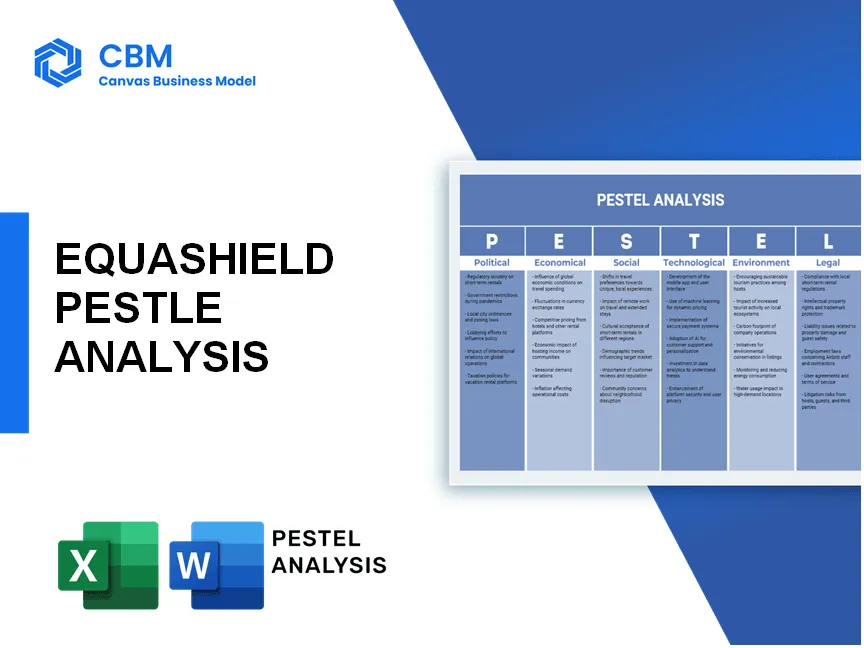In the dynamic landscape of healthcare and life sciences, the Port Washington-based startup Equashield stands at the forefront, poised to make a significant impact. Through a comprehensive PESTLE analysis, we explore the myriad of influences shaping Equashield's operations, from political regulations to environmental concerns. This exploration highlights the complexity of the industry as well as the opportunities that lie ahead. Stay with us as we delve deeper into the vital factors driving Equashield’s strategy and growth.
PESTLE Analysis: Political factors
Compliance with healthcare regulations in the U.S.
Equashield must adhere to stringent healthcare regulations set forth by agencies such as the U.S. Food and Drug Administration (FDA). The FDA's 2021 budget was approximately $6.5 billion, with a significant portion allocated to drug and biologics regulation. Compliance costs for small businesses in the healthcare sector can vary, but on average, they can exceed $150,000 annually for small firms, which includes expenditures for ensuring product safety and efficacy.
Influence of federal healthcare policies on operations
Federal healthcare policies, particularly under the Affordable Care Act (ACA), impact operational frameworks significantly. The ACA has expanded insurance coverage to approximately 20 million additional individuals, influencing the market potential for Equashield's products. Furthermore, significant changes to Medicare and Medicaid reimbursement policies, amounting to $900 billion annually, directly affect revenue streams for healthcare providers.
State-level regulations affecting healthcare practices
Each state has unique regulations affecting healthcare practices. For instance, New York State requires home healthcare providers, which Equashield supplies, to obtain licenses that can cost upward of $50,000. Additionally, in 2022, states like California introduced new legislation requiring healthcare staffing agencies to meet rigorous compliance measures that lead to increased operational costs of roughly 20% on average for those agencies.
Potential changes in political leadership impacting funding
Political leadership changes can significantly impact funding allocation in healthcare. In 2021, federal healthcare spending was approximately $4.1 trillion, with funding for innovative medical technologies being a focus area. Potential shifts in leadership may redirect funds or revise allocations under programs like the National Institutes of Health (NIH), which had a budget of roughly $42 billion in 2021.
Lobbying efforts to shape healthcare legislation
Equashield may engage in lobbying efforts to influence legislation affecting their market. The healthcare industry spent approximately $680 million on lobbying in 2021. The Vital Healthcare Coalition, among other lobbying groups, represents startups and small businesses, advocating for favorable conditions that include tax incentives and support for regulatory relief.
| Factor | Details |
|---|---|
| FDA Budget (2021) | $6.5 billion |
| Average Compliance Costs for Small Firms | $150,000 annually |
| Newly Insured under ACA | 20 million |
| Annual Medicare/Medicaid Spending | $900 billion |
| New York State Licensing Cost | $50,000 |
| Increased Compliance Costs in California | 20% |
| Federal Healthcare Spending (2021) | $4.1 trillion |
| NIH Budget (2021) | $42 billion |
| Healthcare Lobbying Expenditure (2021) | $680 million |
[cbm_pestel_top]
PESTLE Analysis: Economic factors
Growth of the healthcare sector boosting opportunities.
The healthcare sector in the United States is projected to reach a market size of approximately $8.3 trillion by 2027, growing at a CAGR of 8.8% from 2020 to 2027. This robust growth presents significant opportunities for startups like Equashield, particularly in innovative medical solutions.
Economic fluctuations affecting healthcare spending.
Healthcare spending in the U.S. accounted for about 19.7% of the GDP in 2020, reflecting the substantial economic investment in this sector. Economic fluctuations, such as those caused by the COVID-19 pandemic, have led to a 3.6% decrease in healthcare expenditures in 2020, with a rebound of 7.9% predicted for 2021.
Competitive funding landscape for startups.
In 2021, U.S. health tech startups raised roughly $29.1 billion in funding, with investments in digital health leading the way at around $14.7 billion. This competitive funding landscape is critical for startups like Equashield to secure capital for growth.
| Year | Funding Raised (in billion USD) | Notable Investments |
|---|---|---|
| 2021 | 29.1 | Teladoc Health, Doximity, Livongo |
| 2020 | 14.1 | Healthify, Zocdoc |
| 2019 | 11.4 | Grail, Color Genomics |
Impact of insurance reimbursement trends on profitability.
Changes in insurance reimbursement policies significantly influence the profitability of healthcare startups. For instance, Medicare reimbursement for telehealth services saw a drastic increase during the pandemic, leading to an estimated 17% increase in the revenue for related services.
Economic downturns heightening demand for cost-efficient solutions.
During economic downturns, there is a shift towards cost-efficient healthcare solutions. Notably, the Global Market Insights report predicts that the demand for telehealth services will grow by 25% annually, driven by the need for affordable healthcare access. Concurrently, the economic challenges faced by patients have increased demand for products that minimize treatment costs.
PESTLE Analysis: Social factors
Aging population driving healthcare demand
The U.S. Census Bureau estimates that by 2030, approximately 1 in 5 U.S. residents will be of retirement age, a demographic shift that is expected to increase the demand for healthcare services significantly. As of 2022, around 54 million Americans were aged 65 and older, accounting for 16.5% of the total population. This number is projected to reach 73 million by 2030.
Increased focus on health and wellness among consumers
A 2021 report from the Global Wellness Institute indicated that the global wellness economy is valued at approximately $4.4 trillion, with wellness tourism, personal care, and nutrition being significant segments. In the U.S. alone, spending on wellness reached $1.5 trillion in 2020, illustrating a growing consumer focus on health and overall well-being.
Growing awareness of healthcare disparities
According to the Health Resources and Services Administration (HRSA), there were approximately 80 million Americans living in rural areas facing healthcare access issues as of 2021. Furthermore, studies indicate that individuals from disadvantaged backgrounds experience mortality rates that are 20-40% higher than their more affluent counterparts. The Centers for Disease Control and Prevention (CDC) also reported that 50% of Black Americans and 40% of Hispanic Americans reported that their healthcare needs were not met adequately during the COVID-19 pandemic.
Shift towards telehealth and remote care
The pandemic accelerated the adoption of telehealth services, with the proportion of telehealth visits increasing from 11% in 2019 to 46% in 2020, according to McKinsey & Company. By the end of 2022, roughly 70% of consumers expressed interest in continuing to access healthcare services via telehealth post-pandemic. The global telehealth market is projected to reach $636.38 billion by 2028, growing at a CAGR of 37.7% between 2021 and 2028.
Consumer preferences for personalized healthcare solutions
A survey conducted by Accenture in 2021 revealed that 60% of consumers prefer personalized healthcare solutions, including tailored treatment plans and health coaching. Furthermore, the global personalized medicine market was valued at approximately $449.4 billion in 2021 and is projected to grow at a CAGR of 11.5% through 2028. The increase in wearables and digital health applications has further driven consumer demand for personalized healthcare solutions.
| Social Factor | Statistics | Impact |
|---|---|---|
| Aging Population | 1 in 5 Americans will be 65 or older by 2030 | Increased demand for healthcare services |
| Health and Wellness Focus | U.S. wellness spending reached $1.5 trillion in 2020 | Higher investment in the health sector |
| Healthcare Disparities | 80 million Americans in rural areas face access issues | Need for solutions addressing disparities |
| Telehealth Adoption | Telehealth visits increased from 11% to 46% in 2020 | Shift in healthcare delivery model |
| Personalized Solutions | 60% consumer preference for personalized healthcare | Demand for targeted healthcare solutions |
PESTLE Analysis: Technological factors
Advances in medical technology enhancing service delivery
As of 2023, the global digital health market is valued at approximately $215 billion, projected to grow at a CAGR of 27.7% from 2023 to 2030. Advanced technologies such as telemedicine, wearables, and mobile health applications have fundamentally transformed service delivery in healthcare settings.
Increasing reliance on data analytics for decision-making
The healthcare analytics market is estimated to reach $50 billion by 2028, reflecting a CAGR of around 23.8% from 2021. Hospitals leverage data analytics for operational efficiency, patient outcomes, and predictive modeling, enhancing both clinical and administrative decision-making processes.
Integration of AI in healthcare solutions
The AI in healthcare market was valued at $14.6 billion in 2023 and is expected to grow at a CAGR of 37% to reach approximately $188 billion by 2030. AI technologies are being utilized for diagnostics, treatment recommendations, and personalized medicine, driving significant advancements within the industry.
Cybersecurity concerns related to patient data
According to the 2023 Verizon Data Breach Investigations Report, healthcare organizations accounted for 34% of all data breaches across industries. The average cost of a data breach in healthcare reached $10.1 million in 2023, underscoring the urgent need for robust cybersecurity measures.
Rapid innovation cycles in health tech
The pace of innovation in health technology is accelerating, with an estimated 200 new digital health startups launched monthly in 2023. Investment in health technology reached $15 billion in 2022 alone, highlighting the rapid development of new tools and services aimed at improving healthcare delivery.
| Technology Category | Market Value (2023) | CAGR (2023-2030) | Key Applications |
|---|---|---|---|
| Digital Health | $215 billion | 27.7% | Telemedicine, Wearables, Mobile Health |
| Healthcare Analytics | $50 billion | 23.8% | Operational Efficiency, Predictive Modeling |
| AI in Healthcare | $14.6 billion | 37% | Diagnostics, Personalized Medicine |
| Cybersecurity | $10.1 million (average data breach cost) | N/A | Patient Data Protection |
| Health Tech Startups | 200 new startups/month | N/A | Innovative Tools and Services |
PESTLE Analysis: Legal factors
Compliance with HIPAA regulations for patient privacy
The Health Insurance Portability and Accountability Act (HIPAA) has specific provisions for the protection of patient information. In 2021, the U.S. Department of Health and Human Services (HHS) Office for Civil Rights (OCR) received reports of 18,000 HIPAA violations, which reflects the stringent nature of compliance required in the healthcare industry. Failure to comply can lead to fines ranging from $100 to $50,000 per violation, with a maximum annual penalty of $1.5 million.
Intellectual property protections for proprietary technologies
Intellectual property (IP) protections are crucial for startups like Equashield. According to the U.S. Patent and Trademark Office (USPTO), as of 2022, the average cost of obtaining a patent can range from $5,000 to $15,000. The costs associated with litigation for IP infringement can reach an average of $2 million for complex cases. A strong IP portfolio can enhance a startup's valuation, which for health tech companies averaged around $25 million in 2021.
Litigation risks associated with healthcare products
The medical device industry faces substantial litigation risks. As reported by the FDA, 1,260 medical device recalls occurred in 2021, with an associated potential liability of over $200 million per case in damages. Additionally, 79% of healthcare executives reported facing at least one lawsuit related to product liability in a 2022 survey. Equashield must navigate these risks, considering that settlements for medical liability claims averaged $400,000 in 2020.
Employment laws impacting workforce management
Employment laws significantly influence how Equashield manages its workforce. In 2021, employers faced an average legal cost of $160,000 per employee lawsuit, with cases involving wrongful termination making up a significant portion of employment litigation. Consequently, compliance with the Fair Labor Standards Act (FLSA) and Equal Employment Opportunity Commission (EEOC) regulations is essential given the penalties associated with violations can reach $500,000 or more in certain cases.
Changes in FDA regulations affecting product approvals
The approval process for medical devices and products is subject to rigorous scrutiny by the FDA. As of 2023, the average time for a 510(k) clearance was approximately 175 days, with a 35% denial rate. Additionally, the FDA has been increasing its oversight, raising the number of product recalls by 50% from the previous year. Companies that fail to comply with FDA guidelines may face fines averaging $1 million per violation.
| Legal Factor | Impact on Equashield | Financial Repercussions |
|---|---|---|
| HIPAA Compliance | Requires stringent patient information protection | Fines of up to $1.5 million annually |
| Intellectual Property | Securing IP through patents | $5,000 - $15,000 per patent; litigation costs up to $2 million |
| Litigation Risks | Exposure to product liability lawsuits | Average damages per case: $200 million; settlements around $400,000 |
| Employment Laws | Compliance with FLSA and EEOC | Average legal cost: $160,000 per lawsuit; penalties up to $500,000 |
| FDA Regulations | Approval times and oversight | Fines averaging $1 million, with a 35% denial rate |
PESTLE Analysis: Environmental factors
Growing emphasis on sustainable practices in healthcare
The healthcare industry is increasingly focusing on sustainable practices. According to a 2020 report by Healthcare Plastics Recycling Council, over 1.5 million tons of plastic waste is generated annually in U.S. hospitals. A 2021 survey showed that approximately 70% of healthcare institutions are actively working on sustainability initiatives.
Influence of environmental policies on operational strategies
Environmental regulations influence operational strategies significantly. The Environmental Protection Agency (EPA) proposed amendments in 2021 targeting emissions reductions for healthcare facilities, aiming for a 30% reduction by 2030.
Waste management regulations for medical waste
The management of medical waste is tightly regulated. According to the CDC, in 2019, healthcare facilities generated approximately 5.9 million tons of medical waste. The average cost of medical waste disposal is around $0.50 to $3.00 per pound, depending on the type of waste.
| Type of Medical Waste | Percentage of Total Waste | Average Disposal Cost per Pound |
|---|---|---|
| Infectious Waste | 15% | $2.00 |
| Hazardous Waste | 5% | $3.00 |
| Non-Hazardous Waste | 80% | $0.50 |
Climate change impacts on health outcomes
Climate change is a growing concern for health outcomes. According to the World Health Organization (WHO), climate change could cause an additional 250,000 deaths per year between 2030 and 2050 due to malnutrition, malaria, diarrhea, and heat stress.
Corporate social responsibility initiatives in sustainability
Equashield has initiated several corporate social responsibility (CSR) programs aimed at sustainability. In 2022, they invested $1 million in renewable energy projects, contributing to a goal of achieving net-zero emissions by 2040. Furthermore, in a 2023 report, it was noted that approximately 40% of their product lines are designed with sustainable materials, enhancing their commitment to environmental responsibility.
In conclusion, Equashield’s journey as a startup in the competitive landscape of the healthcare and life sciences industry is intricately shaped by a myriad of factors outlined in the PESTLE analysis. Its success hinges on navigating the political landscape while also adapting to economic challenges and leveraging emerging technological advancements. Furthermore, understanding sociological shifts in consumer behavior, adhering to stringent legal requirements, and maintaining a strong commitment to environmental sustainability will be crucial for its growth and impact within the industry. As Equashield continues to innovate, its ability to respond dynamically to these external pressures will define its role in shaping the future of healthcare.
[cbm_pestel_bottom]











